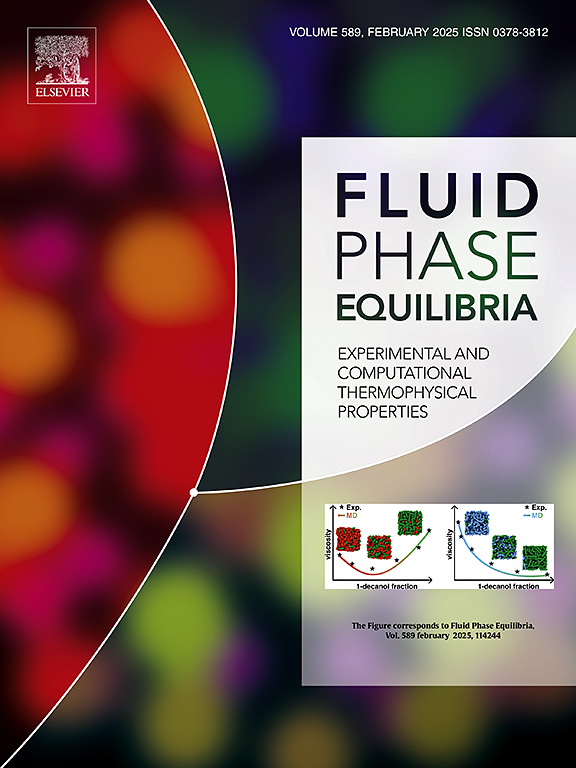富二氧化碳双星系统中H2(高达~ 5%)的气泡点和密度
IF 2.8
3区 工程技术
Q3 CHEMISTRY, PHYSICAL
引用次数: 0
摘要
在这项研究中,实验测量了含有不同浓度的CO2(99.5%, 99%, 98.5%, 98%和~ 95%)与氢(H2)的二元混合物的气泡点。这些测量是从低温(240.20 K)到294.84 K(不确定度为0.14 K),使用恒定成分膨胀法进行的。利用实验数据验证了两种热力学模型——Peng-Robinson和多流体Helmholtz能量近似状态方程(PR-EoS和MFHEA-EoS)。从结果来看,与纯CO2相比,浓度在0.5 - 5%之间的CO2中H2的存在导致了CO2流相行为的显著(~ 19 - 980%)正偏差。这种效应随着H2浓度的升高而增强,随着温度的升高而减弱。两种模型均与实验泡点数据吻合较好,系统平均偏差为<; 4%。值得注意的是,PR-EoS优于MFHEA-EoS,平均偏差为3%。在278.14、298.34、323.55和348.40 K和35 MPa压力下,测量了CO2和H2的密度(99.5%)。在278.06、288.13、298.26和323.53 K和35 MPa压力下,用振动管密度计测量了含有H2的CO2(94.99%)的密度,该密度计用水和氢气校准。对于99.5% CO2二元混合物,模型预测的平均绝对相对偏差(AARD)与MFHEA和PR EoS分别为0.09%和0.26%。MFHEA和PR EoS对94.99% CO2的预测误差分别为0.33%和1.49%。此外,即使在低浓度(0.5%)下,与低压条件下的纯二氧化碳相比,H2的存在也会导致混合物密度大幅降低(35%),这种影响在更高的温度和H2浓度下变得更加明显。两种模型都能很好地预测系统的密度(与实验数据偏差<; 2%),尽管MFHEA-Eos在所有数据点的最大相对偏差(MaxRD) <; 0.4%时更为准确。本文章由计算机程序翻译,如有差异,请以英文原文为准。
Bubble points and densities of H2 (up to ∼ 5%) in CO2-rich binary systems
In this study, experimental measurements of the bubble points of binary mixtures containing varying concentrations of CO2 (99.5 %, 99 %, 98.5 %,98 %, and ∼ 95 %) with hydrogen (H2) were made. These measurements were carried out from low temperatures (240.20 K) up to 294.84 K (with uncertainties of 0.14 K) using the constant composition expansion method. The experimental data were used to validate two thermodynamic models - the Peng-Robinson and Multi-Fluid Helmholtz Energy Approximation Equation of state (PR-EoS and MFHEA-EoS). From the results, the presence of H2 in CO2 at concentrations between 0.5 and 5 % caused a significant (∼19–980 %) positive deviation from the phase behaviour of CO2 stream compared to that of pure CO2. This effect intensified with higher concentrations of H2 and decreased with rising temperatures. Both models demonstrated good agreement with the experimental bubble point data, exhibiting <4 % average deviation for the system. Notably, the PR-EoS outperformed the MFHEA-EoS, showing <3 % average deviation. Densities of CO2 (99.5 %) with H2 were measured at 278.14, 298.34, 323.55, and 348.40 K and pressures up to 35 MPa. While the densities of CO2 (94.99 %) with H2 were measured at 278.06, 288.13, 298.26, and 323.53 K and pressures up to 35 MPa using a vibrating tube densimeter which was calibrated using water and hydrogen. For the 99.5 % CO2 binary mixture, the average absolute relative deviations (AARD) of the model predictions were 0.09 % and 0.26 % against MFHEA and PR EoS respectively. The AARD of the model predictions for the 94.99 % CO2 were 0.33 % and 1.49 % with MFHEA and PR EoS respectively. Furthermore, even at low concentrations (0.5 %), the presence of H2 led to a substantial reduction (>35 %) in the density of the mixture compared to that of pure CO2 at lower pressure conditions with this effect becoming more pronounced at higher temperatures and concentrations of H2. Both models predicted the densities of the system well (with <2 % deviations from the experimental data), though MFHEA-Eos was more accurate with <0.4 % maximum relative deviation (MaxRD) for all the data points.
求助全文
通过发布文献求助,成功后即可免费获取论文全文。
去求助
来源期刊

Fluid Phase Equilibria
工程技术-工程:化工
CiteScore
5.30
自引率
15.40%
发文量
223
审稿时长
53 days
期刊介绍:
Fluid Phase Equilibria publishes high-quality papers dealing with experimental, theoretical, and applied research related to equilibrium and transport properties of fluids, solids, and interfaces. Subjects of interest include physical/phase and chemical equilibria; equilibrium and nonequilibrium thermophysical properties; fundamental thermodynamic relations; and stability. The systems central to the journal include pure substances and mixtures of organic and inorganic materials, including polymers, biochemicals, and surfactants with sufficient characterization of composition and purity for the results to be reproduced. Alloys are of interest only when thermodynamic studies are included, purely material studies will not be considered. In all cases, authors are expected to provide physical or chemical interpretations of the results.
Experimental research can include measurements under all conditions of temperature, pressure, and composition, including critical and supercritical. Measurements are to be associated with systems and conditions of fundamental or applied interest, and may not be only a collection of routine data, such as physical property or solubility measurements at limited pressures and temperatures close to ambient, or surfactant studies focussed strictly on micellisation or micelle structure. Papers reporting common data must be accompanied by new physical insights and/or contemporary or new theory or techniques.
 求助内容:
求助内容: 应助结果提醒方式:
应助结果提醒方式:


